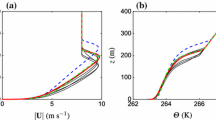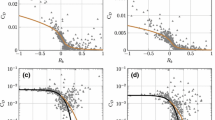Abstract
The transition between the stable and the near-neutral regimes corresponding to weak and strong winds in the stable boundary layer is investigated using four one-dimensional numerical models with increasing numbers of prognostic equations for turbulent variables. The basic state for all the models includes prognostic equations for mean horizontal wind speed, and air and surface temperatures. The simplest model of the four has turbulence variables parametrized using a long-tail stability function and the gradient Richardson number. The complexity of the other three models increases by introducing one more prognostic equation to each model to reduce the number of parametrized turbulent variables: a prognostic equation for turbulent kinetic energy (TKE, e model), an additional prognostic equation for heat fluxes (e-\(F_{H}\) model), and an additional prognostic equation for temperature variances (e-\(F_H\)-\(\sigma _{\theta }\) model). Results for all modells are similar in the strong-wind regime. The two stability regimes can be identified in the relationship between the turbulence velocity scale derived from TKE and mean wind speed from the three models with resolved TKE. However, the weak-wind regime can only be resolved with heat fluxes and temperature variance solved by prognostic equations. Simulations with the removal of the buoyancy term associated with heat fluxes in the TKE equation only result in the strong-wind regime, showing that this term controls the regime transition.








Similar content being viewed by others
References
Acevedo OC, Fitzjarrald DR (2003) In the core of the night-effects of intermittent mixing on a horizontally heterogeneous surface. Boundary-Layer Meteorol 106(1):1–33
Acevedo OC, Costa FD, Degrazia GA (2012) The coupling state of an idealized stable boundary layer. Boundary-Layer Meteorol 145(1):211–228
Acevedo OC, Costa FD, Oliveira PE, Puhales FS, Degrazia GA, Roberti DR (2014) The influence of submeso processes on stable boundary layer similarity relationships. J Atmos Sci 71(1):207–225
Acevedo OC, Mahrt L, Puhales FS, Costa FD, Medeiros LE, Degrazia GA (2016) Contrasting structures between the decoupled and coupled states of the stable boundary layer. Q J R Meteorol Soc 142(695):693–702. https://doi.org/10.1002/qj.2693
André J, De Moor G, Lacarrere P, Du Vachat R (1978) Modeling the 24-hour evolution of the mean and turbulent structures of the planetary boundary layer. J Atmos Sci 35(10):1861–1883
Battisti A, Acevedo OC, Costa FD, Puhales FS, Anabor V, Degrazia GA (2017) Evaluation of nocturnal temperature forecasts provided by the weather research and forecast model for different stability regimes and terrain characteristics. Boundary-Layer Meteorol 162(3):523–546
Blackadar A (1979) High resolution models of the planetary boundary layer. Adv Environ Sci Eng 1(1):50–85
Blackadar AK (1962) The vertical distribution of wind and turbulent exchange in a neutral atmosphere. J Geophys Res 67(8):3095–3102
Costa FD, Acevedo OC, Mombach JC, Degrazia GA (2011) A simplified model for intermittent turbulence in the nocturnal boundary layer. J Atmos Sci 68(8):1714–1729
Cuxart J, Holtslag AAM, Beare RJ, Bazile E, Beljaars A, Cheng A, Conangla L, Ek M, Freedman F, Hamdi R, Kerstein A, Kitagawa H, Lenderink G, Lewellen D, Mailhot J, Mauritsen T, Perov V, Schayes G, Steeneveld GJ, Svensson G, Taylor P, Weng W, Wunsch S, Xu KM (2006) Single-column model intercomparison for a stably stratified atmospheric boundary layer. Boundary-Layer Meteorol 118(2):273–303
Delage Y (1997) Parameterising sub-grid scale vertical transport in atmospheric models under statically stable conditions. Boundary-Layer Meteorol 82(1):23–48
Donaldson C, Rosenbaum H (1968) Calculation of turbulent shear flows through closure of the Reynolds equations by invariant modelling. Aeronautical Research Associates of Princeton, p 127
Duynkerke PG (1988) Application of the e\(-\epsilon \) turbulence closure model to the neutral and stable atmospheric boundary layer. J Atmos Sci 45(5):865–880. https://doi.org/10.1175/1520-0469(1988)045\(<\)0865:AOTTCM\(>\)2.0.CO;2
Ekman VW (1905) On the influence of the earth’s rotation on ocean currents. Ark Mat Astr Fys 2:11
Heisenberg W (1948) On the theory of statistical and isotropic turbulence. Proc R Soc Lond A 195(1042):402–406
Kline S, Morkovin M, Sovran G, Cockrell D (1968) Computation of turbulent boundary layers. In: AFOSR-IFP-stanford conference, vol 2
Köhler H (1933) Meteorologische turbulenz untersuchungen. K Seven vetenskakad handl 13
Kreiss HO, Lorenz J (1989) Initial-boundary value problems and the Navier–Stokes equations, vol 47. SIAM, New Delhi, p 420
Louis JF (1979) A parametric model of vertical Eddy fluxes in the atmosphere. Boundary-Layer Meteorol 17(2):187–202. https://doi.org/10.1007/BF00117978
Mahrt L (1998) Nocturnal boundary-layer regimes. Boundary-Layer Meteorol 88(2):255–278. https://doi.org/10.1023/A:1001171313493
Mahrt L (2017) Stably stratified flow in a shallow valley. Boundary-Layer Meteorol 162(1):1–20. https://doi.org/10.1007/s10546-016-0191-4
Malhi YS (1995) The significance of the dual solutions for heat fluxes measured by the temperature fluctuation method in stable conditions. Boundary-Layer Meteorol 74(4):389–396. https://doi.org/10.1007/BF00712379
McNider RT, England DE, Friedman MJ, Shi X (1995) Predictability of the stable atmospheric boundary layer. J Atmos Sci 52(10):1602–1614. https://doi.org/10.1175/1520-0469(1995) 052\(<\)1602:POTSAB\(>\)2.0.CO;2
Mellor GL, Yamada T (1974) A hierarchy of turbulence closure models for planetary boundary layers. J Atmos Sci 31(7):1791–1806
Mellor GL, Yamada T (1982) Development of a turbulence closure model for geophysical fluid problems. Rev Geophys 20(4):851–875
Oyha Y, Neff DE, Meroney RN (1997) Turbulence structure in a stratified boundary layer under stable conditions. Boundary-Layer Meteorol 83(1):139–162. https://doi.org/10.1023/A:1000205523873
Pielke RA Sr (2013) Mesoscale meteorological modeling, vol 98. Academic Press, New York
Staley D, Jurica G (1972) Effective atmospheric emissivity under clear skies. J Appl Meteorol 11(2):349–356
Steeneveld GJ, van de Wiel BJH, Holtslag AAM (2006) Modeling the evolution of the atmospheric boundary layer coupled to the land surface for three contrasting nights in “CASES-99”. J Atmos Sci 63(3):920–935. https://doi.org/10.1175/JAS3654.1
Sun J, Mahrt L, Banta RM, Pichugina YL (2012) Turbulence regimes and turbulence intermittency in the stable boundary layer during “CASES-99”. J Atmos Sci 69(1):338–351
Sun J, Mahrt L, Nappo C, Lenschow DH (2015) Wind and temperature oscillations generated by waveturbulence interactions in the stably stratified boundary layer. J Atmos Sci 72(4):1484–1503. https://doi.org/10.1175/JAS-D-14-0129.1
Sun J, Lenschow DH, LeMone MA, Mahrt L (2016) The role of large-coherent-Eddy transport in the atmospheric surface layer based on “CASES-99” observations. Boundary-Layer Meteorol 160(1):83–111. https://doi.org/10.1007/s10546-016-0134-0
Svensson G, Holtslag AAM, Kumar V, Mauritsen T, Steeneveld GJ, Angevine WM, Bazile E, Beljaars A, de Bruijn EIF, Cheng A, Conangla L, Cuxart J, Ek M, Falk MJ, Freedman F, Kitagawa H, Larson VE, Lock A, Mailhot J, Masson V, Park S, Pleim J, Söderberg S, Weng W, Zampieri M (2011) Evaluation of the diurnal cycle in the atmospheric boundary layer over land as represented by a variety of single-column models: the second “GABLS” experiment. Boundary-Layer Meteorol 140(2):177–206
Taylor MG (1915) I: Eddy motion in the atmosphere. Philos Trans R Soc Lond A 215(523–537):1–26
Therry G, Lacarrere P (1983) Improving the Eddy kinetic energy model for planetary boundary layer description. Boundary-Layer Meteorol 25(1):63–88. https://doi.org/10.1007/BF00122098
van Hooijdonk IGS, Donda JMM, Clercx HJH, Bosveld FC, van de Wiel BJH (2015) Shear capacity as prognostic for nocturnal boundary layer regimes. J Atmos Sci 72(4):1518–1532. https://doi.org/10.1175/JAS-D-14-0140.1
van der Linden SJA, Baas P, van Hooft JA, van Hooijdonk IGS, Bosveld FC, van de Wiel BJH (2017) Local characteristics of the nocturnal boundary layer in response to external pressure forcing. J Appl Meteorol Clim 56(11):3035–3047. https://doi.org/10.1175/JAMC-D-17-0011.1
van de Wiel B, Ronda R, Moene A, De Bruin H, Holtslag A (2002) Intermittent turbulence and oscillations in the stable boundary layer over land “part I”: a bulk model. J Atmos Sci 59(5):942–958
van de Wiel BJH, Moene AF, Jonker HJJ, Baas P, Basu S, Donda JMM, Sun J, Holtslag AAM (2012a) The minimum wind speed for sustainable turbulence in the nocturnal boundary layer. J Atmos Sci 69(11):3116–3127. https://doi.org/10.1175/JAS-D-12-0107.1
van de Wiel BJH, Moene AF, Jonker HJJ (2012b) The cessation of continuous turbulence as precursor of the very stable nocturnal boundary layer. J Atmos Sci 69(11):3097–3115. https://doi.org/10.1175/JAS-D-12-064.1
Wyngaard JC (1975) Modeling the planetary boundary layer: extension to the stable case. Boundary-Layer Meteorol 9(4):441–460. https://doi.org/10.1007/BF00223393
Wyngaard JC, Coté O (1974) The evolution of a convective planetary boundary layera higher-order-closure model study. Boundary-Layer Meteorol 7(3):289–308
Xu D, Taylor PA (1997) On turbulence closure constants for atmospheric boundary-layer modelling: neutral stratification. Boundary-Layer Meteorol 84(2):267–287
Acknowledgements
The study was supported by Conselho Nacional de Desenvolvimento Científico e Tecnológico (CNPq) (Grant No. 307024/2017-2) and by Coordenação de Aperfeiçoamento de Pessoal de Nível Superior (CAPES).
Author information
Authors and Affiliations
Corresponding author
Rights and permissions
About this article
Cite this article
Maroneze, R., Acevedo, O.C., Costa, F.D. et al. Simulating the Regime Transition of the Stable Boundary Layer Using Different Simplified Models. Boundary-Layer Meteorol 170, 305–321 (2019). https://doi.org/10.1007/s10546-018-0401-3
Received:
Accepted:
Published:
Issue Date:
DOI: https://doi.org/10.1007/s10546-018-0401-3




